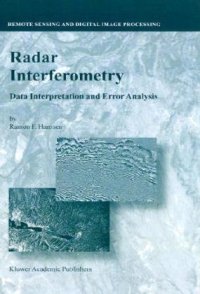
Ebook: Radar Interferometry: Data Interpretation and Error Analysis
Author: Ramon F. Hanssen (auth.)
- Tags: Remote Sensing/Photogrammetry, Geophysics/Geodesy, Statistics for Engineering Physics Computer Science Chemistry & Geosciences, Meteorology/Climatology
- Series: Remote Sensing and Digital Image Processing 2
- Year: 2002
- Publisher: Springer Netherlands
- Edition: 1
- Language: English
- pdf
This book is the product of five and a half years of research dedicated to the und- standing of radar interferometry, a relatively new space-geodetic technique for m- suring the earth’s topography and its deformation. The main reason for undertaking this work, early 1995, was the fact that this technique proved to be extremely useful for wide-scale, fine-resolution deformation measurements. Especially the interf- ometric products from the ERS-1 satellite provided beautiful first results—several interferometric images appeared as highlights on the cover of journals such as Nature and Science. Accuracies of a few millimeters in the radar line of sight were claimed in semi-continuous image data acquired globally, irrespective of cloud cover or solar illumination. Unfortunately, because of the relative lack of supportive observations at these resolutions and accuracies, validation of the precision and reliability of the results remained an issue of concern. From a geodetic point of view, several survey techniques are commonly available to measure a specific geophysical phenomenon. To make an optimal choice between these techniques it is important to have a uniform and quantitative approach for describing the errors and how these errors propagate to the estimated parameters. In this context, the research described in this book was initiated. It describes issues involved with different types of errors, induced by the sensor, the data processing, satellite positioning accuracy, atmospheric propagation, and scattering character- tics. Nevertheless, as the first item in the subtitle “Data Interpretation and Error Analysis” suggests, data interpretation is not always straightforward.
This volume is devoted to satellite radar interferometry (InSAR), a relatively new remote sensing technique used for geodetic applications such as topographic mapping and for high-accuracy monitoring of deformation of the Earth's crust. It offers a geodetic perspective of the technique, using a functional and a stochastic model to describe the relation between the observations and parameters and to discuss issues such as accuracy, robustness, and error propagation. It explains both theory and applications and provides a resource for future studies in the field. Radar Interferometry presents a geodetic technique, complementary to GPS, laser altimetry, photogrammetry, and leveling and comments on its pros and cons for various applications. It features the technique of radar interferometry meteorology, a new application in the field of atmospheric studies. Fine-resolution mapping of the atmospheric water vapor distribution offers new insights for meteorologists. Audience: Radar Interferometry: Data Interpretation and Error Analysis is designed for researchers and professionals in geodesy, geophysics, and meteorology that can benefit from the use of remote sensing using interferometric radar.